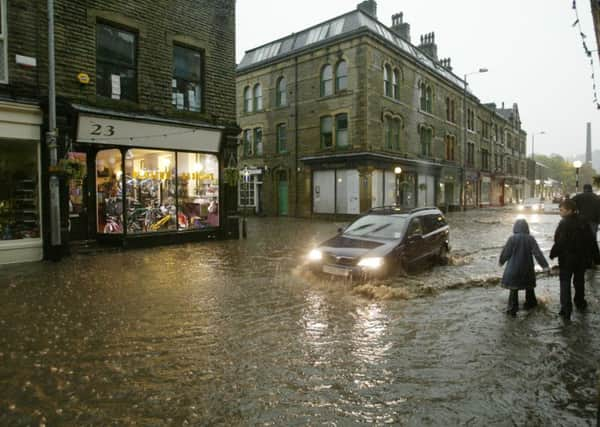Colin Mellors: If floods are '˜new normal', how can we best prepare?


The facts themselves are straightforward. Yorkshire experienced its third-highest November rainfall since 1910; the following month, its highest-ever December total. Boxing Day’s rain fell on saturated ground with little capacity to absorb further water.
The Calder, Aire, Wharfe, Swale, Ure, Nidd and Foss all reached exceptionally high levels in places breaking previous records by a significant margin. In Armley, the Aire reached 5.2m against a previous high of 4.03m in 2000 and, in Sowerby Bridge, the Calder topped at 3.55m, well above its 2012 record of 2.43m. By the end of December 26, 141 flood warnings (meaning “take immediate action”) and 24 severe warnings (signifying “danger to life”) had been issued.
Advertisement
Hide AdAdvertisement
Hide AdThe consequences were graphically depicted in images that dominated the media. For those flooded, of course, it was much more than an image – inflicting enormous financial, material and emotional damage, with the prospect of months of upheaval while homes and lives are reconstructed. The impact on businesses and jobs is no less significant.
Nowhere was the destructive power of nature more evidenced than in the Calder Valley where lives might easily have been lost. The event also demonstrated the human spirit that prevails in such circumstances – local authorities, the Environment Agency, the emergency services and, in some parts of the region, the military working day and night.
Most of all, communities themselves exemplified that spirit. In Calderdale, voluntary flood wardens, and social media, were instrumental in alerting residents to what was happening. Across West and North Yorkshire, communities quickly organised themselves
The focus now is on recovery, not just of homes but also of businesses and infrastructure. Across the region, there was disruption to the rail and road network as well as the loss of power, phone lines and mobile services. The vulnerability of key infrastructure will inevitably be studied closely.
Advertisement
Hide AdAdvertisement
Hide AdWhile this vital work is underway, and operational lessons are already being learned, it is time, too, to think longer-term. “Unprecedented” was the word widely used to describe last month’s weather and, on this occasion, it was no exaggeration. But, what if such events become more frequent?
The starting point, however difficult, is to acknowledge that there is no guaranteed way of protecting everyone, and everywhere, from the risk of flooding in such severe circumstances. It is no coincidence that experts increasingly talk about “managing flood risk” and “improving resilience” rather than “preventing flooding”. Put somewhat unscientifically, if huge volumes of water fall suddenly in concentrated areas then that water has to go somewhere.
This is not to imply that engineered solutions – barriers, pumps, storage – will stop being the core of flood defence. There is a major six-year capital investment programme already in place, involving many highly-innovative schemes. Homes that would otherwise have flooded last month were protected through recent initiatives.
Engineered approaches, however, can only ever be part of the response. A whole catchment-based approach is necessary – water that falls on the Dales, Moors and Wolds passes through our cities, towns and villages on its way to the Humber.
Advertisement
Hide AdAdvertisement
Hide AdRetaining and dispersing water before it reaches people and property is important. Although natural environmental solutions are not feasible everywhere, woodland, upland reservoirs and emergency use of agricultural land to hold water can help. Pickering’s “slowing the flow” initiative is an example.
Informing new development is another ingredient – both where homes are built and how they might incorporate flood protection measures.
If we accept that flooding can never be fully prevented, there will be need for clear appreciation of the importance of resilience – by national and local authorities, by communities and by individual homeowners. Specifically, what each can do in practical terms to mitigate the risks, minimise the damage and speed recovery.
There are measures – flooring, plastering, wiring and siting of electrical sockets, one-way valves, installation of water resistant doors and windows – that can reduce the impact. Property repairs now underway present an obvious opportunity to introduce such measures.
Advertisement
Hide AdAdvertisement
Hide AdFinally, how should we convey the level of risk? Regrettably, despite the understandable dismay of residents, it is possible for so-called “1-in-100” year events to occur with greater frequency than the phrase might imply.
Also, even if the severity and likelihood of the risk can be communicated, awareness is of little use if residents are uncertain what can be done by way of mitigation.
Enhanced physical and engineered schemes accompanied by natural environmental solutions, greater emphasis on resilience, and improved awareness will all be required if December’s unprecedented event does, in fact, become the new norm.
Colin Mellors is chair of the Yorkshire Region Flood and Coastal Committee.